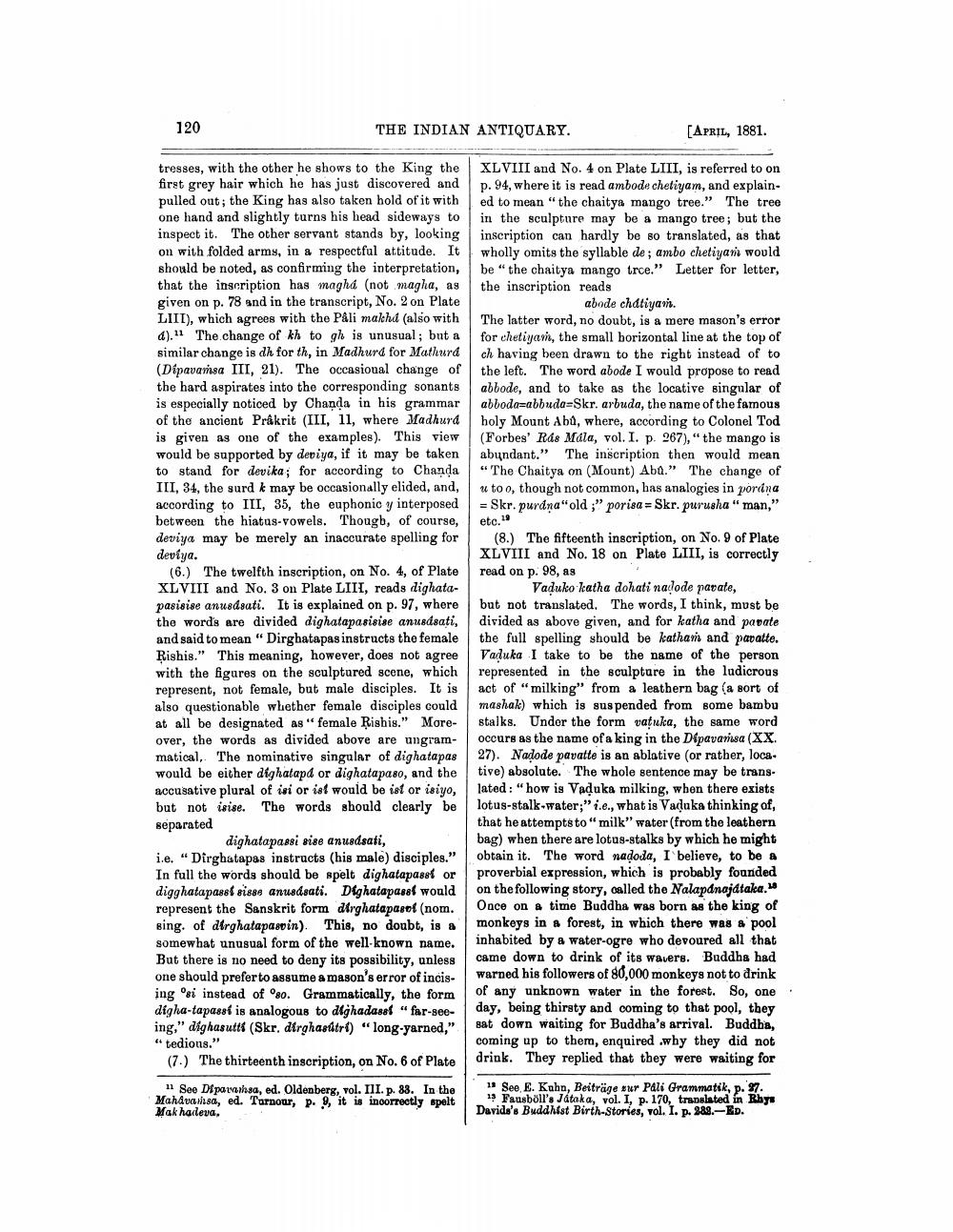________________
120
THE INDIAN ANTIQUARY.
[APRIL, 1881.
XLVIII and No. 4 on Plate LIII, is referred to on p. 94, where it is read ambode chetiyam, and explained to mean "the chaitya mango tree." The tree in the sculpture may be a mango tree; but the inscription can hardly be so translated, as that wholly omits the syllable de; ambo chetiyan would be "the chaitya mango trce." Letter for letter, the inscription reads
abode chatiya». The latter word, no doubt, is a mere mason's error for chetiyam, the small horizontal line at the top of ch having been drawn to the right instead of to the left. The word abode I would propose to read abbode, and to take as the locative singular of abboda=abbuda-Skr. arbuda, the name of the famous holy Mount Abů, where, according to Colonel Tod (Forbes' Ras Mdla, vol. I. p. 267)," the mango is abundant." The inscription then would mean “The Chaitya on (Mount) Abd.” The change of u too, though not common, has analogies in pordana = Skr. purdna"old;" porisa = Skr. purusha "man,"
etc.
tresses, with the other he shows to the King the first grey hair which he has just discovered and pulled out; the King has also taken hold of it with one hand and slightly turns his head sideways to inspect 10. The other servant stands by, looking on with folded arms, in a respectful attitude. It should be noted, as confirming the interpretation, that the inscription has magha (not magha, as given on p. 78 and in the transcript, No. 2 on Plate LIII), which agrees with the PAli makhd (also with d). The change of th to gh is unusual; but a similar change is dh for th, in Madhurd for Mathura (Dipavansa III, 21). The occasional change of the hard aspirates into the corresponding sonants is especially noticed by Chanda in his grammar of the ancient Prakrit (III, 11, where Madhura is given as one of the examples). This view would be supported by deviya, if it may be taken to stand for devika; for according to Chanda III, 34, the surd k may be occasionally elided, and, according to III, 35, the euphonic y interposed between the hiatus-vowels. Thougb, of course, deviya may be merely an inaccurate spelling for deviya.
(6.) The twelfth inscription, on No. 4, of Plate XLVIII and No. 3 on Plate LIII, reads dighatapasisise anusdsati. It is explained on p. 97, where the words are divided dighatapasisise anusdsati, and said to mean "Dirghatapas instructs the female Rishis." This meaning, however, does not agree with the figures on the sculptured scene, which represent, not female, but male disciples. It is also questionable whether female disciples could at all be designated as " female Risbis." Moreover, the words as divided above are ungrammatical. The nominative singular of dighatapas would be either dighatapd or dighatapaso, and the accusative plural of isi or ist would be ist or isiyo, but not isise. The words should clearly be separated
dighatapassi sise anusdsati, ie. “Dirghatapas instructs (his male) disciples." In full the words should be spelt dighatapasst or digghatapasst sisse anusdsati. Dighatapassi would represent the Sanskrit form dirghatapasol (nom. sing, of dirghatapasnin). This, no doubt, is a somewhat unusual form of the well-known name. But there is no need to deny its possibility, unless one should prefer to assume a mason's error of incising 'si instead of '80. Grammatically, the form digha-tapassi is analogous to dlghadasal "far-seeing," dighasutt (Skr, dirghasutri) "long-yarned," tedions." (7.) The thirteenth inscription, on No. 6 of Plate " Soe Dipavaihsa, ed. Oldenberg, vol. III. p. 88. In the Mahdu . ad. Tarnonr. . . ia incorrectl Analt Makharleva.
(8.) The fifteenth inscription, on No. 9 of Plate XLVIII and No. 18 on Plate LIII, is correctly read on p. 98, as
Vaduko katha dohati na lode parate, but not translated. The words, I think, must be divided as above given, and for katha and parate the full spelling should be katha and paratte. Vaduka I take to be the name of the person represented in the sculpture in the ludicrous act of "milking" from a leathern bag (a sort of mashak) which is suspended from some bambu stalks. Under the form vatuka, the same word occurs as the name of a king in the Dipavarisa (XX. 27). Nadode pavatte is an ablative (or rather, locative) absolute. The whole sentence may be translated : "how is Vaduka milking, when there exists lotus-stalk-water;" i.e., what is Vaduka thinking of, that he attempts to "milk" water (from the leathern bag) when there are lotus-stalks by which he might obtain it. The word nadoda, I believe, to be a proverbial expression, which is probably founded on the following story, called the Nalapdnajdtaka. Once on a time Buddha was born as the king of monkeys in a forest, in which there was a pool inhabited by a water-ogre who devoured all that came down to drink of its wavers. Buddha had warned his followers of 80,000 monkey, not to drink of any unknown water in the forest. So, one. day, being thirsty and coming to that pool, they sat down waiting for Buddha's arrival. Buddha, coming up to them, enquired .why they did not drink. They replied that they were waiting for
13 See E. Kuhn, Beiträge sur Pali Grammatik, p. 97.
1 Fausbüll's Játaka, vol. I. p. 170. trwaleted in Rhy Davids's Buddhist Birth-Stories, vol. I. p. 389.-ED.




